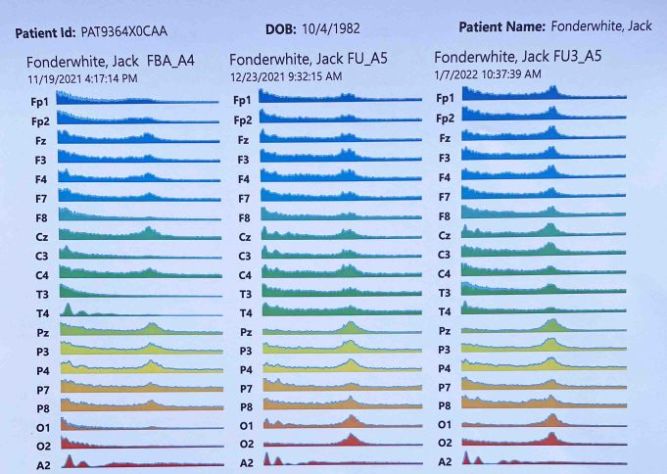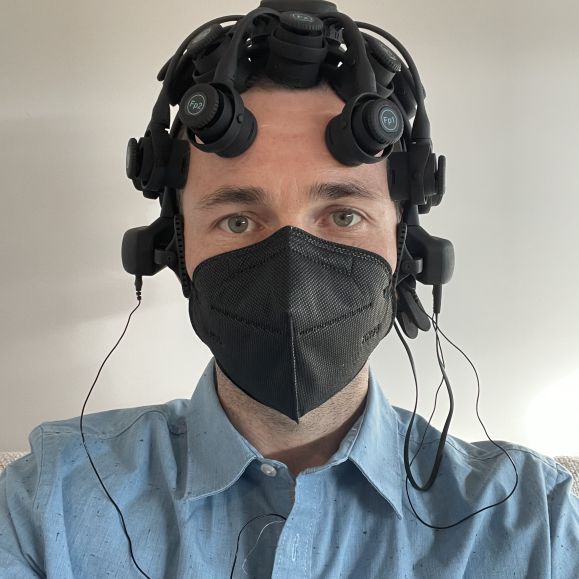The Origin of PeakMIND
Did you know PeakMIND neurostimulation is a scalp electroacupuncture innovation I pioneered to heal my own persistent chronic concussion symptoms? This is the story of how a grad school presentation on concussions and my own medical needs became the genesis of PeakMIND.
Scene 1: The Presentation
Towards the end of my masters program, an instructor challenged our class to choose one particular condition we would like to potentially specialize in. At the end of the course, we would have to give a presentation on the condition and current solutions. I reflected on my experience in sports, especially my years training and competing in kickboxing in Japan, and chose concussion.
At the time, I had chosen the topic as a matter of professional interest, but the more I developed my presentation, the more I realized how personal interest may have also played a role in my choice. Looking back at it now, I had no idea how personal the topic would become or how significantly it would impact my professional trajectory.
During my review of concussion information and literature online, something began to stand out to me. There wasn’t as much information on the topic as I would’ve expected. In fact, I felt like I was struggling to find enough information to create a worthwhile presentation on the topic at all.
Of course, there were lots of articles on concussion. There were studies on how concussions occur and how they affect people. There were statistics on the most common symptoms, causes, and injury numbers, but there wasn’t much information about objective assessments or effective treatments.
Even in 2017, it was as though concussions were not only very much at the beginning of their exploration within the medical community, but that robust solutions were also still very much lacking.
I compiled what information I could, created a slideshow, and gave my presentation. My class enjoyed the presentation and I got an excellent grade, but in the end, I left the course and my program feeling as though I didn’t sufficiently understand concussion or know of any robust solutions.
That would have to change when patients started presenting to my private clinic with concussion symptoms.
Scene 2: The Concussions
The first concussion that presented in my private practice was 3 years after my presentation. The patient had been in a car accident and was visiting for neck pain. English was her second language and I understood little about how to approach traumatic whiplash like hers. I also hadn’t been made aware of the cause of her neck pain until after the second visit. So, overall, things didn’t go well.
In fact, some of the work seemed to exacerbate her symptoms after the first two treatments. This is typical, I would learn, in cases of concussion. At the time, however, I hadn’t even realized she might have been suffering from concussion symptoms. I didn’t recognize the less obvious signs and symptoms.
The second case would be much better.
The second case was a former soccer player who also boxed. They were experiencing lingering symptoms from a concussion 6 months earlier, and this was their third concussion that they could remember.
They said things felt like they were getting better until they returned to light sport activity. Then things immediately worsened again. Headaches. Brain fog. Feeling dreamy, and like junk. Their doctor and concussion specialist weren’t providing any successful solutions, so they decided to try acupuncture.
Fortunately, because of my experience with the previous whiplash case, I had already started learning a bit more about concussion. I had completed an acupuncture course on concussion, reviewed an at-home concussion recovery program meant for patients, and started following leaders in the field.
Thanks to what I had learned, this patient made significant improvements in just 7 visits. They were so hopeful that real improvement was possible that they decided to seek additional treatment elsewhere.
Success!
Now, you’re probably thinking, “A patient deciding to seek treatment with another provider sounds like failure…or at least doesn’t portend well for business.”
Believe it or not, this patient going to another clinic was a crucial moment for Jackupuncture and my patients. This was the genesis moment for PeakMIND.
Scene 3: The Brain Scan (EEG)
This patient told the medical director at the brain health clinic he went to about his experience with Jackupuncture. Apparently, this doctor was very impressed. He had never heard of anyone providing the kinds of treatments or results this patient had received at our clinic. Intrigued, the doctor invited me to his office to discuss my work.
After getting lost on my way to the office, I found myself sweaty and waiting in a small office with a little window. As I stared out at the tops of the surrounding buildings, I was unaware of how much my life was about to change.
The doctor came in with a big smile and introduced himself. After telling me about his work and asking about mine, he enthusiastically gave me an EEG. Then, we reviewed the findings.
There was a graph of hills painted in a rainbow of colors. Some of the hills were bumpy or split. Some were mostly flat. This, I would learn, was not a healthy brain.

These are my real EEG findings before, during, and after PeakMIND. In these charts, brain activity is plotted along a horizontal axis. The taller the colorful hill, the “healthier/more normal” the activity. The shorter and wider the hill, the less ideal the activity. In the chart on the left, November 19, my brain function is quite poor. In the middle, after starting PeakMIND, we see a significant increase in activity in all regions of the brain. On the right, at the end of one series of PeakMIND, we see the activity has continued to improve, with taller, sharper hills. This is a much healthier level of brain function.
As it turned out, there were 8 regions of my brain that weren’t operating optimally. Those were the flat lines.
To say this was a surprise is an understatement. This was the same brain that helped me graduate at the top of my master’s program, start a successful medical practice, and excel enough in my craft to be invited into a larger medical facility by a neuropsychiatrist to discuss my work.
I thought to myself, what’s possible if all the regions of my brain are functioning!?
I set out to answer that question.
Scene 4: PeakJACK
Based on my conversation with the neuropsychiatrist, I developed a strategy. I combined some of what I did for the soccer-playing boxer and my other fighters with a few additions to treat my own particular needs. I also adapted a few things from texts I had read from more established practitioners in scalp acupuncture, which has a 50 year clinical history of helping with a whole host of neurological conditions. So, with my tools and plans ready, I began Jackupuncture’s first-ever series of neurostimulation.
When I returned to the doctor’s office for a new EEG after my first round of what would become PeakMIND, his staff was blown away.
In just a few weeks, the neurostimulation protocol had restarted the brain regions that had been dormant. The flat lines had regained life, climbing towards the sky like their colorful compatriots, while other hills had become sharper and more pronounced. This all represented a healthier, more vibrant brain.
So I plugged myself in for another round of neurostimulation and returned for a third EEG a few weeks later.
What did we see on the third EEG? Was the previous scan a fluke? Dumb luck? Placebo?
We saw what my PeakMIND neurostimulation patients now regularly experience: every performance metric of every region measured was continuing to significantly improve. Hills were becoming hillier. My brain was becoming brainyer.
There was no denying it. I felt great and my EEGs looked great!
Scene 5: A New Mission
In every respect possible, my world and life had become so much better, internally and externally. It felt as though I had exited an invisible haze that had slowly engulfed me over decades, preventing me from truly experiencing the world. Colors, smells, tastes, emotions, movements were all sharper, cleaner, more tangible, vibrant.
I finally understood so many issues I had been experiencing, and saw the light at the end of the tunnel for so many other people in a position like mine. I wanted to share this with other athletes and fighters, my friends, and my community. Improving brain health had become my mission.
With PeakJACK on the job, I spent the next few months reading books on brain health, discussing concussions and acupuncture with colleagues, and seeking out additional resources.
Some of my patients noticed the difference in my attitude and demeanor and asked what I was doing. Once I shared my story with them, they started asking a lot of questions:
“Do you think it would help with depression?”
“Would it be good for anxiety?”
“Would this help my memory?”
“What if I never had a concussion or mental illness?”
“Can this help with dementia and Alzheimer’s?” I got that one a lot.
I was cautious but hopeful with my responses.
It was logical to me that improving brain function, coherence, and efficiency as seen in my EEGs would benefit others. It also had to be very likely that the same thing that led to the healing of my injured brain would also benefit an uninjured one. After all, movement and exercise are as much a part of maintaining a healthy lifestyle as they are a part of recovery in physical therapy. So, why wouldn’t a healing therapy for an injured brain also be a potential tonic for an uninjured one?
In most cases, after explaining my reasoning and the successful history of scalp acupuncture, I was able to confidently recommend PeakMIND as a solution to patients for injured and uninjured brains, alike.
Patients immediately started referring friends and family.
Scene 6: The Afterword
Since having healed my own brain, many other Jackupuncture patients have experienced the great restoration of life PeakMIND makes possible. After concussion, it has helped patients with acute and chronic symptoms successfully return to work, school, and sport after long lay offs. It has resolved psychosis and hallucinations, as well as severe PTSD, depression, and anxiety in several notable cases.
For myself and my patients, PeakMIND neurostimulation is proving to be an excellent way of maintaining a vibrant and healthy mental life for all brains, as well as a robust solution for restoring health to acutely and chronically injured ones.
In one interesting case, a local author sought PeakMIND to help with their productivity. Not only did they attribute their PeakMIND results to being able to finish their recent novel in record time, their eyesight improved so much that they had to change the prescription for their glasses. Thanks to the benefits of neurostimulation, their more than 70 years old brain is now performing like that of a 35 year old’s. They have now forbidden me from leaving Oahu until their entire 10-book series is complete!
In another case, a patient suffering from 7 months of persistent chronic concussion symptoms was not only able to return to work symptom free, their lifelong narcolepsy was also resolved as a side effect. In many cases, actually, patients have noted positive unexpected side effects like this, including improved balance, better sleep, and even the resolution of tinnitus.
And, yes, as it turns out, PeakMIND can help with some forms of dementia, too. More on that in the future.

